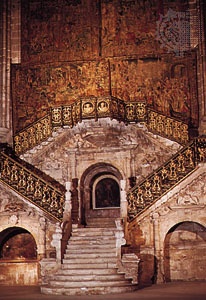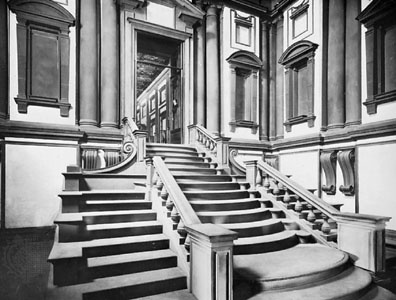staircase
architecture
 series, or flight, of steps between two floors. Traditionally, staircase is a term for stairs accompanied by walls, but contemporary usage includes the stairs alone.
series, or flight, of steps between two floors. Traditionally, staircase is a term for stairs accompanied by walls, but contemporary usage includes the stairs alone.The origin of the staircase is uncertain. On the road up Mount Tai in China there are many great flights of ancient granite steps; the earliest staircases seem to have been built with walls on both sides, as in Egyptian pylons that date from the 2nd millennium BC. The Cretan palaces, as at Knossos and Phaistos (both c. 1500 BC), make important use of stairs, and the Assyrian ziggurat of the 9th or 8th century BC was often adorned with massive stairs. The palace terrace at Persepolis has a double flight of steps (6th century BC) of great beauty. The Romans introduced barrel-vaulted flights of stairs enclosed by walls in the interiors of their theatres, as well as spiral stairs in the thickness of the walls.
 The enclosed tunneled flights were revived in the early Renaissance, but open interior staircases on an ambitious spatial scale cannot really be found before Michelangelo's at the Laurentian Library (Medicean-Laurentian Library), Florence (1524–71). Thereafter, dramatic staircases became one of the defining features of Baroque architecture, as exemplified in the Augustusburg Castle at Brühl, near Cologne, designed by Balthasar Neumann (Neumann, Balthasar), and in the Royal Palace at Caserta, near Naples, by Luigi Vanvitelli (Vanvitelli, Luigi). An early and influential example of exposed staircases within a glazed tower is those designed in 1914 by Walter Gropius (Gropius, Walter) for the Deutscher Werkbund exhibition building in Cologne, Ger.
The enclosed tunneled flights were revived in the early Renaissance, but open interior staircases on an ambitious spatial scale cannot really be found before Michelangelo's at the Laurentian Library (Medicean-Laurentian Library), Florence (1524–71). Thereafter, dramatic staircases became one of the defining features of Baroque architecture, as exemplified in the Augustusburg Castle at Brühl, near Cologne, designed by Balthasar Neumann (Neumann, Balthasar), and in the Royal Palace at Caserta, near Naples, by Luigi Vanvitelli (Vanvitelli, Luigi). An early and influential example of exposed staircases within a glazed tower is those designed in 1914 by Walter Gropius (Gropius, Walter) for the Deutscher Werkbund exhibition building in Cologne, Ger.Staircases have traditionally been built of wood, stone or marble, and iron or steel. The use of steel and reinforced concrete has made possible the daring curves and fantastic sweeps that can be important features in contemporary design. The horizontal surface of a step is called its tread and the vertical front its riser; steps are placed between strings that are inclined to the angle of the staircase; strings are supported by newel posts that also support the handrail, forming a balustrade.
- Georg Jellinek
- Georg Jenatsch
- Georg Jensen
- Georg Joachim Rheticus
- Georg Kaiser
- Georg Kerschensteiner
- Georg Ledebour
- Georg Michaelis
- Georg Muffat
- Georg Philipp Harsdörfer
- Georg Philipp Telemann
- Georg Raphael Donner
- Georg, Ritter von Schönerer
- Georg Schönerer, Ritter von
- Georg Simmel
- Georg Simon Ohm
- Georg Spalatin
- Georg Stiernhielm
- Georg Trakl
- Georg von Békésy
- Georg von Dollmann
- Georg von Frundsberg
- Georg von Peuerbach
- Georg von Reichenbach
- Georg Waitz